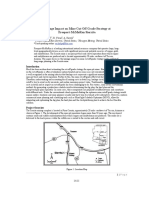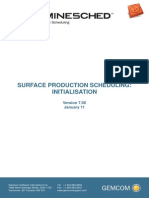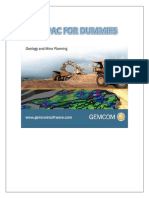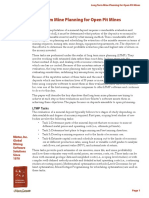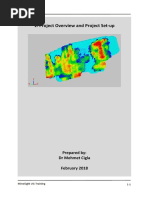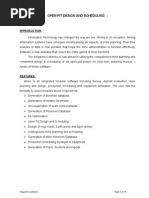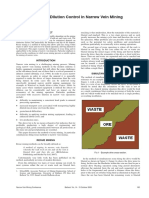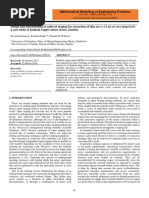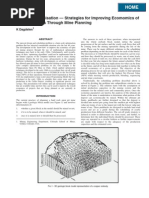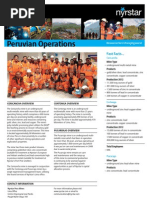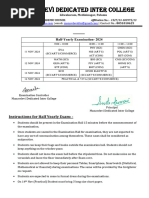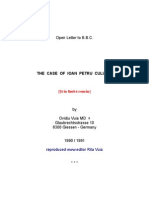0 ratings0% found this document useful (0 votes)
285 viewsWhittle SplitShell
Whittle SplitShell
Uploaded by
Washington BobadillaThe document discusses the application of split shell open pit design at De Beers Venetia mine in South Africa. Previously, mine design was based on conventional concentric mining, which has operational downsides like congestion and increased costs from high stripping ratios early in the mine life. The split shell concept was proposed to address this by splitting large mining cuts into two separate pushbacks on opposite sides of an axis, allowing for more flexible operations and deferred stripping costs. Whittle optimization was used to determine suitable split axes and pushback limits. Analysis found the split shell approach improved economics by targeting higher grade areas earlier while deferring waste.
Copyright:
Attribution Non-Commercial (BY-NC)
Available Formats
Download as PDF, TXT or read online from Scribd
Whittle SplitShell
Whittle SplitShell
Uploaded by
Washington Bobadilla0 ratings0% found this document useful (0 votes)
285 views8 pagesThe document discusses the application of split shell open pit design at De Beers Venetia mine in South Africa. Previously, mine design was based on conventional concentric mining, which has operational downsides like congestion and increased costs from high stripping ratios early in the mine life. The split shell concept was proposed to address this by splitting large mining cuts into two separate pushbacks on opposite sides of an axis, allowing for more flexible operations and deferred stripping costs. Whittle optimization was used to determine suitable split axes and pushback limits. Analysis found the split shell approach improved economics by targeting higher grade areas earlier while deferring waste.
Copyright
© Attribution Non-Commercial (BY-NC)
Available Formats
PDF, TXT or read online from Scribd
Share this document
Did you find this document useful?
Is this content inappropriate?
The document discusses the application of split shell open pit design at De Beers Venetia mine in South Africa. Previously, mine design was based on conventional concentric mining, which has operational downsides like congestion and increased costs from high stripping ratios early in the mine life. The split shell concept was proposed to address this by splitting large mining cuts into two separate pushbacks on opposite sides of an axis, allowing for more flexible operations and deferred stripping costs. Whittle optimization was used to determine suitable split axes and pushback limits. Analysis found the split shell approach improved economics by targeting higher grade areas earlier while deferring waste.
Copyright:
Attribution Non-Commercial (BY-NC)
Available Formats
Download as PDF, TXT or read online from Scribd
Download as pdf or txt
0 ratings0% found this document useful (0 votes)
285 views8 pagesWhittle SplitShell
Whittle SplitShell
Uploaded by
Washington BobadillaThe document discusses the application of split shell open pit design at De Beers Venetia mine in South Africa. Previously, mine design was based on conventional concentric mining, which has operational downsides like congestion and increased costs from high stripping ratios early in the mine life. The split shell concept was proposed to address this by splitting large mining cuts into two separate pushbacks on opposite sides of an axis, allowing for more flexible operations and deferred stripping costs. Whittle optimization was used to determine suitable split axes and pushback limits. Analysis found the split shell approach improved economics by targeting higher grade areas earlier while deferring waste.
Copyright:
Attribution Non-Commercial (BY-NC)
Available Formats
Download as PDF, TXT or read online from Scribd
Download as pdf or txt
You are on page 1of 8
Strategic Mine Planning Conference Perth, WA, 26 - 28 March 2001 121
FIG 1 - Venetia Mine locality maps.
larger as the pit gets deeper.
around the orebody. Each mining cut becomes progressively
E-mail: mgallagher@debeers.co.za
concentric mining principle mines a waste cut or pushback 360
Limited, Private bag X01, Southdale 2135, South Africa.
been based on a conventional concentric mining method. The
2. Senior divisional Mining Engineer, De Beers Consolidated Mines
Open pit design and planning at Venetia mine has, in the past,
E-mail: rmkear@mweb.co.za
CONCENTRIC MINING
1. Mining Advisor, PO Box 4512, Edenvale 1610, South Africa.
accordingly, as shown in Table 1.
run in Whittle by modifying the slope zones in the parameter file
mine daily.
waste tonnes of the flattening angles, a series of scenarios were
Messina, Alldays and Lebowa and is bussed to and from the
were, at the time, under review. To assess the potential impact on
mine into full production in 1993. The workforce is housed in
Figure 3). The slope angles for the various regions in the pit
Prestripping and construction commenced in 1990 phasing the
determine the final economic shell and push back limits (see
community, Alldays, as shown in Figure 1.
Whittle Four-D optimisation was performed on the kimberlites to
west of the town of Messina and 40 km east of the farming
south of the confluence of the Shashe and Limpopo rivers, 80 km WHITTLE FOUR-D OPTIMISATION
in the Northern Province of South Africa, approximately 27 km
Venetia mine is located on the farm VENETIA 103MS, situated
which 4.2 million tonnes is ore sent for processing.
Venetia currently mines some 29 million tonnes per annum of
INTRODUCTION
excess of 300 MPa.
strengths of the country rock types varies from 100 MPa to in
De Beers Venetia open pit in South Africa.
Metaporphic terrane in which it is situated. The intact rock
This paper discusses the application of the split shell design at the
rock is extremely complex and typical of the Limpopo
design.
region, which causes planar failure. Deformation of the country
iterations are possible thereby closing the gap between optimal and actual
NPV of the reserve. With comp u u n te fa r v t o ec u h r n a o b l l o y gy o , r n i u e m nt e a r t o e u d s c m on e c ta e m pts or a p n h d ic layering in the southern
receives the least attention, yet it is the area of most influence on the complex jointed host rock, which is further complicated by
production scenarios to planning initiatives. Of all, planning usually
Gneiss, biotite schist and amphibolites mainly comprise the
achieve this, ranging from operational efficiency improvements through
synformal structure.
improved margins become the focal objective. There are many ways to
kimberlites appear to be contained within the centre of a
Mining is no different, with falling prices and escalating costs,
satellite kimberlites being mined as the open pit expands. The
plan, with optimum economics.
form the basis of the mine plan, with the remainder of the
alternatives to improve their operations. The ultimate goal is to deliver to
kimberlites, K001 and K002 being 12.5 ha and 5 ha respectively,
but flexible design thereby allowing operational managers to provide
To remain at the leading edge, in any business, depends on accurate Figure 2), varying in size from <1 ha to 12.5 ha. The two largest
In today s high tech world, syste V m e s n a e r t e ia ge m tti i n n g e b c ig o g n e s r, is f t a s ste o r f , b a ett c e l r u . ster of 14 kimberlite pipes (see
ABSTRACT GEOLOGY
R M Kear and M S Gallagher
1 2
Mine South Africa Using the Whittle and Gemcom Software
Split Shell Open Pit Design Concept Applied at De Beers Venetia
122 Perth, WA, 26 - 28 March 2001 Strategic Mine Planning Conference
Maximum production scenario years 22.83 22.84 23.00 22.14
strategies
Realistic production scenario years 29.75 29.76 29.97 28.85
Depletion
Minimum production scenario years 31.49 31.50 31.71 30.56
Life of mine
Strip ratio waste:ore 6.72 5.59 4.59 6.80
Waste tons 000 s tons 680 899 566 927 468 783 669 270
parameters
Total kimberlite tons 000 s tons 101 395 101 431 102 106 98 410
Resource
Satellite kimberlite tons 000 s tons 16 685 15 958 15 727 13 278
K001/K002 kimberlite tons 000 s tons 84 710 85 473 86 379 85 132
Slope degrees 35 S - 40 N 40 S - 45 N 45 S - 50 N 36 S - 40 N
pit design
Units Whittle shell Whittle shell Whittle shell Current final
Whittle shell slope angle analysis.
TABLE 1
value of the reserve could be improved.
further investigations were persued to determine whether the
FIG 3 - Three-dimensional view of the Venetia Whittle shell.
constraints associated with concentric mining and based on this,
Mine. It was found that split shells obviate some of the
initiated to prove up the applicability of this method at Venetia
proposed the split shell concept. Design work and planning was
and increase cost. Robin Kear, a mining advisor to the mine,
ramp closure from blast spillage, all of which reduce efficiencies
mining activities, waste dilution on top of ore and temporary
mining of different push backs which results in the congestion of
from high stripping ratios earlier in the life of mine, concurrent
once critically examined, has operational downsides. These range
Concentric mining, although traditional, workable and proven,
investigated.
of better returns, mine design criteria and philosophies were
Cost profiles mirror waste stripping profiles therefore in pursuit
increases significantly year on year as the pit depth increases.
In order to maintain ore feed to the plant, waste stripping
FIG 2 - Plan view of the Venetia kimberlites.
R M KEAR and M S GALLAGHER
Strategic Mine Planning Conference Perth, WA, 26 - 28 March 2001 123
FIG 4 - Schematic showing the difference between conventional concentric mining and split shell mining.
previous stages.
costs are acceptable.
configuration rules that obey the split axis determined in the
of risk is associated with a period of time for which development
Conduct multiple pit designs incorporating the ramp
life is a risk management must take. The basis for an assessment
the shell the first split will be mined.
In view of current market conditions, the size of the cut, hence
jointing and stability, which may influence on which side of
the deposit wealth, inefficiencies from over stripping are masked.
Assess the country rock for competence, fault planes,
Concentric mining compounds this scenario. Quite often, due to
instantaneous stripping ratios and early capital expenditure.
plant blending purposes and finally ore release extent.
increased risk due to the longevity of that cut, requiring higher
cognisance of geometry, grade, rock type characteristics for
wider waste cuts than the required minimum resulting in Determine the most suitable split axis of the orebody taking
to be conservative when determining push-back distance and take
Re-design current mining cut, modifying ramps if necessary.
increased stripping. Planners on many large open pit mines tend
for the successful split. columns, etc) for longer periods, but there is a price to pay -
beyond a point that will allow ramp configurations necessary advantage of establishing roadways and services (pumping
the remaining mine life. In some cases, mining has advanced Large waste cuts do have more associated ore and have the
mining status. This will establish if a split is possible at all on
double that of a split shell.
Assess the current design, taking cognisance of the current
mining, the capital, infrastructure and time committed is virtually
cut. In other words, the costs may be sunk up-front. In concentric
described below:
required to maintain production for the duration of that particular
The process is iterative and generally follows the sequence
of that entire cut, as capital expenditure and infrastructure will be
cut and hence capital and operating cost.
commenced, the mine is to some extent committed to the mining
reduced waste tonnage profile due to the split in the mining
can bring revenue forward. Once the particular cut has
reduced Business Risk Period (BRP); and graded areas while deferring waste which in turn defers cost and
split axis. The split shell presents opportunities to target higher
since the mining cut is split and is not being mined at once;
factors need to be considered when sizing and determining the
increased flexibility in both operations and future planning,
calculated risk that the management team must take. These
equipment in working areas;
production rate, ramp geometry, market confidence etc and is a
improved operational efficiencies due to less congestion of
number of factors such as equipment size, final planned depth,
The correct push-back distance or waste cut is determined by a
reduced waste spillage on ore access ramps;
ramp; PUSH-BACK/WASTE CUT DETERMINATION
taking place on the opposite side of the pit to that of the ore
unobstructed ore haul route access due to waste mining
in Figure 4.
also incorporates various operational advantages, such as: a re-schedule of intermediate cuts or push backs and is illustrated
life, without putting exposed ore at risk for mining. The concept final pit shell nor does it reduce total tonnes mined - it is merely
waste stripping to be deferred from the early part of the waste cut The split shell design does not significantly alter the size of the
The direct benefit of the split shell design is that it allows for
splits are possible.
opposite halves of each design.
into the short-term plans. On certain large deposits, multiple
along an axis, creating two separate push-backs and joining the
shells to determine the bottleneck, which will ultimately feed
The concept is based on the principle of splitting a pit shell
Select the optimum split designs and sequence these interim
method of waste stripping.
designs available for splitting.
Split Shell mining departs from the conventional concentric
joined split shell each time to determine the optimum
SPLIT SHELL CONCEPT Split and merge the different designs, evaluating the resultant
SPLIT SHELL OPEN PIT DESIGN CONCEPT APPLIED AT DE BEERS VENETIA MINE SOUTH AFRICA
124 Perth, WA, 26 - 28 March 2001 Strategic Mine Planning Conference
FIG 5 - Cut two and three concentric designs.
Cut two
Cut three
K001
K001
K002
K002
inefficiencies. The ramp system in the second split, when mined
from deferred waste stripping far out weigh any haul cycle
shells using the Gemcom mine planning software (see Figure 5).
reduce truck cycle times slightly, the economic benefits derived
and concentric practical pits were designed from these Whittle
points will take the form of switch-backs, and although they will
limits or waste cuts. In total, four waste cuts were established,
points. During the mining of the first split, these ramp transition
conducted on the optimum shell to establish optimal push back
the edges of the split axis, and these effectively form transition
determining the final economic pit shell. Analysis was further
configured in such a way that cross over points are established at
Whittle Four-D optimisation was run on Venetia mine,
has been decided, as described earlier, the ramps have to be
one of the critical factors to determine. Once the correct split axis VENETIA MINE - A CASE STUDY
Ramp configuration, for the success of the split shell design, is
designs can the optimum design be achieved.
considered.
adopting an iterative approach and running a series of ramp
economics, however practical aspects of this will have to be
gradient and direction all need to be evaluated and only by
reduce ramp width considerably which would further improve
and practicality is the trick. Considerations such as width, up or empty down passage. This does provide the opportunity to
choose the optimal ramp design which maximises profitability
certain ramps could be designated one way, allowing either full
ramp designs and configurations that could be generated, but to
Due to the multiple ramp system in the split shell design,
Given an optimal pit design from Whittle, there are a range of
benefits from improved design such as split shells will be lost.
often some of the stages are omitted due to time constraints.
factors of safety before any design work is performed, otherwise
theoretical pits to practical pits could take several stages, but
envelope are being pushed while remaining within acceptable
determined by the mining engineer. The evolution from
ascertain all design criteria and ensure upper limits of the design
and when they should be mined, but how to mine these is
million tonnes of waste rock. It is therefore important to
Whittle Four-D will determine the blocks which are mineable
limit by some 16 metres, which resulted in an additional 20
without deviating too much from the mathematical optimum.
that three-metre increase in ramp width, pushed out the final pit
engineer has to transform this optimal pit into a practical pit,
and tonnes, based on a 400 metre deep pit. The results concluded
Having discussed the theory behind optimal pits, the mining
conducted to determine the effects of ramp widths on final design
a commensurate increase in waste tonnage. An exercise was
IMPACT OF RAMPS ON OPTIMAL PITS
on the final pit perimeter and any increase in width will result in
Haulroad width is a design parameter that has significant affect
contribute favourably to operating efficiency and NPV.
system, therefore business risk is reduced.
semi-permanent roadways and services. All of these factors
portion of ramp between crossover points and not the entire ramp
improving flexibility while still allowing for the establishment of
Loss of a ramp segment on the split shell only isolates that small
reducing high instantaneous stripping ratios, BPR s are reduced
means use of the entire ramp is lost until repairs can be effected.
mining the split shell, waste stripping is deferred thereby
split shell design. Losing a segment of a concentric ramp usually
split shell without affecting the overall life of the waste cut. By
on concentric designs has longer term effects than that o o p n er t a h t e ing life of each waste cut according to the limits of the
it, resulting in separate mining cuts. This effectively divides the working areas and reduces the risk of ramp failure. Ramp failure
Development of split shells takes one waste cut design, splits required in the splits which increases flexibility for access to the
One of the benefits of the split shell is the multiple ramp
is prepared to invest capital (Seymour, 1997).
business, and represents the period of time over which an owner the split.
fundamental parameters which needs to be defined for any were originally designed as one in the whole waste cut prior to
The Business Risk Period (BRP) is one of the most down, will merge to form one common ramp system, since they
R M KEAR and M S GALLAGHER
Strategic Mine Planning Conference Perth, WA, 26 - 28 March 2001 125
FIG 6 - Cut two and three split axis.
Cut three
Cut two
South split
K001
K001
K002
K002
North split Split axis
increase wear and tear on haultruck transmissions. As can be Adjustments to the bottleneck can have major effects on the
areas which could increase waste tonnes and operationally, they bottleneck higher or lower between the two cuts being mined.
minimised as they tend to push out the shell perimeters in these north and Cut three south splits - this process actually moves the
given to ensure that flat sections on the cross over points are
are required by adjusting the working levels between the Cut two
larger cuts, cross over or transition points. Attention must be
while the opposite split is uneconomical. A series of trade-offs
establishment of switchbacks on the current mining cut and on
economics are balanced such that one split is not ultra efficient
bottom of Cut three south. Ramp modifications usually require
trading one split off against the other to ensure that the
bottom of Cut two was possible from the north split, and to the
stage is to correctly balance the splits. This process involves
ramps on the concentric cut designs ensuring that access to the
Having determined the split shells and ramp systems, the final
configuration is achieved. The first stage was to modify the
under-go a series of designs to ensure B th A e L o A p N tim C u I m NG ra T m H p E SPLITS
play an important role in the success of a split shell and need to
in both Cut two and Cut three. As mentioned previously, ramps
split ramp system.
concentric designs were necessary to accommodate the split shell
haul route will transfer to the southern side utilising the southern
while Cut three south is mined. Ramp modifications to the
on the south to sustain plant feed, mining of ore, and thus the ore
geology section, it was decided that Cut two north would remain
merge at the ore working levels. Once sufficient ore is exposed
poorer host rock conditions in the south, as described in the
starts exposing ore causing Cut two north and Cut three south to
Taking cognisance of the above reasons and considering the
which the split being mined, in Venetia s case Cut three south,
grade and blend? bottleneck has been reached. The bottleneck is the point at
- will the split ensure adequate ore release at the required eventually begin to expose ore. When this occurs, it is said the
orebody geometry and grade distribution across the orebody develops, the south split advances, gets deeper and will
this case Cut three south, as shown in Figure 9. As mining
mining back to stable ground?; and
while waste is hauled from the pit via the other ramp system, in
deteriorated such that the only way to make them safe require
using one ramp system, in this case the Cut two north ramp,
geotechnical issues - are there any areas of the pit that have
independent ramp systems. Ore will be hauled out of the pit
existing ramps?;
It is clear in the split shell design that there are two
current pit status - on which side is it best to modify the
eventually re-joined as one, known as the Cut three south split.
as:
achieved. Figure 8 shows how the two shells were split and
mentioned previously, many factors influence this decision such
them together ensuring that practical and workable merging was
which side the first split would be taken, either north or south. As
The next phase was to split the shells along the axis and stitch
Having determined the split, the next step was to ascertain on
the ramp.
orebody as shown in Figure 6.
This marginally offset the increased waste tonnage required for
constraints. As it was, the final split did run east west across the
that the safety berm in the original design could be removed.
cognisance of geometric, plant blending, grade and ore release
tonnes slightly, although by having an additional ramp meant
determine the best practical split axis, all the time taking
the south. The insertion of this Cut three ramp did increase waste
however iterations were still performed and analysed to
the southern side thereby providing access to the K002 pit from
with the natural split running along the longitudinal axis,
split. Cut three required a completely new ramp to be inserted on
The Venetia orebody geometry lends itself to split shell mining
inserting switchbacks thereby keeping the ramps north of the
cuts. systems for both the K001 and K002 pits required changes by
resulting in the concept being applied on the remaining three modifications to the current concentric designs. Cut two ramp
Cut one had been mined before split shells were introduced seen in Figure 7 below, Venetia mine required slight
SPLIT SHELL OPEN PIT DESIGN CONCEPT APPLIED AT DE BEERS VENETIA MINE SOUTH AFRICA
126 Perth, WA, 26 - 28 March 2001 Strategic Mine Planning Conference
in Cut three south design is well into the developed pit -
to be very useful in this regard.
main pit interchange to the bottom of the pit. Where this occurs
yet accurate results. Gemcom mine planning software has proven
concern, being that only one ramp system is present from the
requires user-friendly mine planning software that provides rapid
what-ifs and detailed analysis there was only one point of
optimising the splits efficiently, due to the number of iterations,
to be turned when looking for what can go wrong. After many
north and Cut three south bottleneck is met. Balancing and
office, mine management and production crews. Every stone had
commencing the Cut three north stripping to ensure the Cut three
method, requires buy-in from all stake holders, those being head
with the Cut three south split will determine the timing of
being such a radical departure from the traditional concentric
a major role in the split efficiency. The amount of ore associated
Introducing a new concept such as the split shell, particularly
therefore the economics of such are extremely sensitive and play
associated or R e I a S n K d S waste assigned to a particular split and
FIG 8 - Splitting and joining of the shells.
Cut three south Cut three south Split
Cut two north
FIG 7 - Cut two and three ramp re-design to accommodate the split shell design.
Cut two Cut three
Access K002
to
Additional ramp required
R M KEAR and M S GALLAGHER
Strategic Mine Planning Conference Perth, WA, 26 - 28 March 2001 127
Face shovels -1 -1 -1 -1 -1
Haultrucks -2 -6 -8 -8 -9
Earth moving equipment reduction as a result of reduced tonnes from split shell - progressive
Prog variance Tonnes 10 -5.7 -13.2 -20.8 -30.6 -42.5
6
Variance Tonnes 10 -5.7 -7.5 -7.6 -9.8 -11.9
6
Final split shell Tonnes 10 12.9 15.3 19.5 20.0 20.0
6
1998 concentric plan Tonnes 10 18.6 22.8 27.1 29.8 31.9
6
Scenario Unit 1999 2000 2001 2002 2003
Summary of split shell results.
TABLE 2
revised split shell. Essentially, the waste contained in the peak
reduction in waste tonnes has reduced earthmoving requirements
1998 Concentric plan, to 20 million tonnes per annum in the
have been deferred to the later years in the life of the mine. This
rate has been reduced from 32 million tonnes, as required in the
period in the years 1999 to 2005, as shown in the 1998 plan,
demonstrate that through an iterative process, the peak mining
by approximately eight per cent. Table 2 and Figure 10
five years by some 30 per cent and improved the Cut three NPV
FIG 10 - Waste tonnage comparison between the various designs.
25 per cent, reduced the five year earthmoving fleet over the next
operating expenditure at Venetia mine in 1999 by approximately
The adoption of the split shell concept reduced capital and
RESULTS
mining method.
compared to the risk assessment associated with the concentric
split. Risk for the split shell at Venetia was reduced when
northern side if required, or alternatively accelerate the northern
situation becomes critical, there is room to insert a ramp on the
minor changes to design here and there. In addition, if the
information will be updated on an ongoing basis allowing for
maintains sidewall and ramp integrity and geotechnical
bench 13. By that stage, blasting should be of a standard that
FIG 9 - Showing dedicated haul routes for ore and waste in the split shell.
SPLIT SHELL OPEN PIT DESIGN CONCEPT APPLIED AT DE BEERS VENETIA MINE SOUTH AFRICA
128 Perth, WA, 26 - 28 March 2001 Strategic Mine Planning Conference
FIG 11 - Haultruck fleet size comparison.
Programming Pty Ltd: Melbourne).
Proceeding Optimising with Whittle Perth 1997 (Whittle
Seymour, C, 1997. Risk Based Selection of Pit Shells for Scheduling, in
Years
1999 2002 2005 2008
REFERENCE
0
giving permission to publish and present this paper.
5
The authors would like to thank the management of De Beers for
10
ACKNOWLEDGEMENTS
15
Cut three (as currently indicated) to post Cut four.
20 result could possibly delay underground mining from post
the improvement of the overall mining economics, and as a
25
Final Split Shell expenditure; and
Haultruck Requirements
1998 Concentric Plan of reduced working costs and deferment of capital
the immediate savings on the operation s cash flow by means
been:
Longer-term benefits, tonnes and haultruck reductions, are
The main achievements of split-shells at Venetia Mine have
required to covert from concentric design to split shell design.
optimisation stage, a deeper pit should result.
both split shell scenarios as these were the minimum tonnes
with the split shell concept therefore if applied in the
You will note that the first three years tonnes are the same in
application. Theoretically, the economics of the pits improve
time, Whittle would require to consider this concept in its
1st split shell Tonnes 10 12.9 15.3 19.5 23.5 25.5
6 possible provided the skills and expertise are available, and in
The exercise at Venetia Mine proved that split shell concepts are
the split shell.
CONCLUSION
tonnage profile below is what was achieved on the first pass of
Arriving at the optimum design is an iterative process the
NPV of the mine.
improved the economics.
in which revenue is pulled forward and has further improved the
have improved the workability of the plan and ultimately
shown that the split shell design has allowed for grade profiling
has consistent tonnage for longer periods. All of these factors
Subsequent planning, focusing on an NPV+ principle has
costs and optimised equipment usage by providing a plan that
(trucks and shovel) hence capital expenditure, reduced working shown for the life of Cut 3 in Figures 10 and 11.
R M KEAR and M S GALLAGHER
You might also like
- 4.09 Deswik - Sched For UGM Tutorial v4.1Document191 pages4.09 Deswik - Sched For UGM Tutorial v4.1Margareth Guerrero Arias100% (2)
- Guidelines for Mine Waste Dump and Stockpile DesignFrom EverandGuidelines for Mine Waste Dump and Stockpile DesignMark HawleyRating: 3.5 out of 5 stars3.5/5 (3)
- CBSE Class 3 Mathematics - Geometry PDFDocument2 pagesCBSE Class 3 Mathematics - Geometry PDFhoneylibra9378100% (9)
- Strategic Mine Planning SurpacWhittleDocument308 pagesStrategic Mine Planning SurpacWhittlebruktawit100% (1)
- Whittle Parameters ExplanationsDocument4 pagesWhittle Parameters ExplanationsDiana Catalina MuneraNo ratings yet
- Manual Minesched 8.0 PDFDocument192 pagesManual Minesched 8.0 PDFjuan francisco urzua ramirez50% (2)
- Surpac Underground Ring DesignDocument50 pagesSurpac Underground Ring DesignP100% (1)
- MineSched NotesDocument18 pagesMineSched NotesRobert Nyirenda100% (2)
- APCOM - Haulage Impact On Mine Cut-Off Grade StrategyDocument8 pagesAPCOM - Haulage Impact On Mine Cut-Off Grade StrategyJorgeNo ratings yet
- Planning For Narrow Vein Mines: G GemellDocument4 pagesPlanning For Narrow Vein Mines: G GemellBendigo BanksNo ratings yet
- So Where Are You FromDocument1 pageSo Where Are You Fromapi-554523447No ratings yet
- Rock Blasting - A Practical Treatise On The Means Employed In Blasting Rocks For Industrial PurposesFrom EverandRock Blasting - A Practical Treatise On The Means Employed In Blasting Rocks For Industrial PurposesNo ratings yet
- 01 Surface Production Initialisation V70Document112 pages01 Surface Production Initialisation V70Ricardo Contreras B100% (2)
- Stockpile and Cut-Off Optimization ModuleDocument1 pageStockpile and Cut-Off Optimization ModuleRicardo Contreras BNo ratings yet
- Pit DesignDocument94 pagesPit Designminguejacobo2No ratings yet
- Lecture 7 2010 Open Pit Planning and DesignDocument38 pagesLecture 7 2010 Open Pit Planning and DesignFelichi Dacumos Balajadia100% (1)
- Pit DesignDocument99 pagesPit DesignSeyedRezaMiner100% (1)
- Advanced Underground Design LongwallDocument32 pagesAdvanced Underground Design Longwalljuan carlosNo ratings yet
- Advanced Underground Design Reporting PDFDocument89 pagesAdvanced Underground Design Reporting PDFjuan carlosNo ratings yet
- Underground Mine DesignDocument47 pagesUnderground Mine Designalfri121No ratings yet
- MODEL - Lerchs-Grossman OptimizationDocument41 pagesMODEL - Lerchs-Grossman OptimizationDouglas Yusuf33% (3)
- Using SurpacDocument19 pagesUsing Surpacprimo_techNo ratings yet
- Block ModellingDocument83 pagesBlock Modellingalfri121100% (1)
- NPVS Course Level 2Document31 pagesNPVS Course Level 2Juan David Rondinel BulejeNo ratings yet
- Short-Term Production Planning in Open Pit Mines Using Dynamic Shovel AllocationsDocument20 pagesShort-Term Production Planning in Open Pit Mines Using Dynamic Shovel AllocationsPatrick Nizeyimana100% (1)
- 07 Underground Scheduling Headings V70Document92 pages07 Underground Scheduling Headings V70georgesar7No ratings yet
- Cut Off Grade Based Stope Optimisation To Maximise Value at The Garpenberg Mine 5Document90 pagesCut Off Grade Based Stope Optimisation To Maximise Value at The Garpenberg Mine 5Ramadhani Ndonde100% (1)
- Whittle Introductory Poly Metallic TutorialDocument21 pagesWhittle Introductory Poly Metallic Tutorialhenry_mineroNo ratings yet
- Long Term Mine Planning For Open Pit Mines: Mintec, Inc. Global Mining Software Solutions Since 1970Document16 pagesLong Term Mine Planning For Open Pit Mines: Mintec, Inc. Global Mining Software Solutions Since 1970NurlanOruzievNo ratings yet
- Intro To VulcanDocument242 pagesIntro To VulcanNik Agarwal67% (3)
- BM Validate For Whittle Output FunctionDocument5 pagesBM Validate For Whittle Output Function.No ratings yet
- Ultimate Pit Design Using Surpac: Mentored ByDocument40 pagesUltimate Pit Design Using Surpac: Mentored Byjunaifa100% (2)
- Underground Ring Design PDFDocument49 pagesUnderground Ring Design PDFАнхбаяр БатболдNo ratings yet
- Mine Planning With GEOVIA MineSched-rev01Document26 pagesMine Planning With GEOVIA MineSched-rev01Hizkiel 17No ratings yet
- Deswik-40Document138 pagesDeswik-40LUIS EDUARDO PARRANo ratings yet
- Drill and Blast in Surpac 6.0: July 2007Document79 pagesDrill and Blast in Surpac 6.0: July 2007excalibur59100% (1)
- MM2016 Part 21 Micromine Scheduler 10 2016 New PDFDocument104 pagesMM2016 Part 21 Micromine Scheduler 10 2016 New PDFDadan Saefudin Rosidi100% (1)
- Technical Design of The Bukwimba Open Pit Final 12042017Document31 pagesTechnical Design of The Bukwimba Open Pit Final 12042017Rozalia Pengo100% (2)
- Underground Mining Design and PlanningDocument113 pagesUnderground Mining Design and PlanningJinzhi FengNo ratings yet
- Whittle ParametersDocument4 pagesWhittle ParametersGUSTAVO NAVARRO POPPENo ratings yet
- A New Mine Planning Tool For Sub Level Caving Mines: White PaperDocument18 pagesA New Mine Planning Tool For Sub Level Caving Mines: White Paperacad100% (1)
- drillAndBlast PDFDocument54 pagesdrillAndBlast PDFLauraValeroMNo ratings yet
- Block Size Selection and Its Impact On Open-Pit Design and Mine PlanningDocument8 pagesBlock Size Selection and Its Impact On Open-Pit Design and Mine PlanningKevin RiosNo ratings yet
- NPVS Course Level 2Document30 pagesNPVS Course Level 2Edward ChirinosNo ratings yet
- Minesched TutorDocument17 pagesMinesched TutorRavael Simanjuntak100% (3)
- What Your Boss Expects You To Know About Grade Control PDFDocument9 pagesWhat Your Boss Expects You To Know About Grade Control PDFJose Coca100% (1)
- Polygons and OutlinesDocument95 pagesPolygons and OutlinesTessfaye Wolde GebretsadikNo ratings yet
- A Holistic Approach To Mine PlanningDocument11 pagesA Holistic Approach To Mine PlanningLucide Ingele100% (2)
- Geostats ENG 042111 PDFDocument387 pagesGeostats ENG 042111 PDFOmar Ramírez100% (1)
- Project Overview and Project Set-UpDocument87 pagesProject Overview and Project Set-UpNurlanOruzievNo ratings yet
- Open Pit DesignDocument17 pagesOpen Pit Designyogesh shinde100% (1)
- GEMS Block Modelling LABSDocument70 pagesGEMS Block Modelling LABSTessfaye Wolde GebretsadikNo ratings yet
- Resue Firing and Dilution Control in Narrow Vein MiningDocument3 pagesResue Firing and Dilution Control in Narrow Vein MiningMostafaOmid0% (1)
- Chapter 2Document12 pagesChapter 2Saye B.DoloNo ratings yet
- Pit Planing and DesignDocument6 pagesPit Planing and DesignKeiko Uriol ReyesNo ratings yet
- Fragblast: International Journal For Blasting and FragmentationDocument20 pagesFragblast: International Journal For Blasting and FragmentationPatricio CisternasNo ratings yet
- Bamber 2004Document12 pagesBamber 2004manuelgltNo ratings yet
- Cutoff-Grade Analysis at Fazenda Brasile PDFDocument12 pagesCutoff-Grade Analysis at Fazenda Brasile PDFJoão BatistaNo ratings yet
- UG Design and Support - 083238Document53 pagesUG Design and Support - 083238Quinton Dean ChingokaNo ratings yet
- Module-2 Planning of New Coal MinesDocument53 pagesModule-2 Planning of New Coal Minesrudresh svNo ratings yet
- Design and Dimensioning of Sublevel Stoping For ExDocument6 pagesDesign and Dimensioning of Sublevel Stoping For ExJóse AntonioNo ratings yet
- JKBench InstallDocument2 pagesJKBench InstallWashington BobadillaNo ratings yet
- Hand Calculation 2 - Simple Homogeneous Wet SlopeDocument10 pagesHand Calculation 2 - Simple Homogeneous Wet SlopeWashington BobadillaNo ratings yet
- Codigos de Los RGBDocument4 pagesCodigos de Los RGBWashington BobadillaNo ratings yet
- DagdelenDocument4 pagesDagdelenWashington BobadillaNo ratings yet
- Peruvian Operations: Fast Facts..Document2 pagesPeruvian Operations: Fast Facts..Washington BobadillaNo ratings yet
- AQA Language NEA ExamplesDocument71 pagesAQA Language NEA ExamplesReen SNo ratings yet
- Ending The Mendel-Fisher ControversyDocument2 pagesEnding The Mendel-Fisher Controversybiarca8361No ratings yet
- HRSG DeaeratorDocument2 pagesHRSG DeaeratorTripoli2010No ratings yet
- 11TH Exam NoticeDocument1 page11TH Exam Noticeyadojee500No ratings yet
- Group 4Document8 pagesGroup 4Kristiana LeañoNo ratings yet
- Instituto Mixto Miguel de Cervantes Saavedra English Guide Activity #3 Reading Comprehension Practice Read The Following TextDocument2 pagesInstituto Mixto Miguel de Cervantes Saavedra English Guide Activity #3 Reading Comprehension Practice Read The Following TextANDRESNo ratings yet
- Inclining ExperimentDocument20 pagesInclining ExperimentABHISHEK SINGH100% (1)
- Interview With John FrawleyDocument11 pagesInterview With John FrawleyJohnette RicchettiNo ratings yet
- Issues and Concerns in CurriculumDocument22 pagesIssues and Concerns in CurriculumMichelleManguaMiron100% (4)
- BK4A-001-TS-TP2-RPT-04 - 26 Inch Pipeline Wall Thickness Calculation Report - 1 - 100414Document9 pagesBK4A-001-TS-TP2-RPT-04 - 26 Inch Pipeline Wall Thickness Calculation Report - 1 - 100414Hiếu NguyênNo ratings yet
- Mining AssignmentDocument9 pagesMining Assignmentabelmusonda33No ratings yet
- TMW 2018YearlyPlanner PDFDocument58 pagesTMW 2018YearlyPlanner PDFKristina MilićevićNo ratings yet
- 2.5kW Data Sheet V - 2.0Document11 pages2.5kW Data Sheet V - 2.0shivendra singhNo ratings yet
- Pressure Equipment - European Commission NORMASDocument23 pagesPressure Equipment - European Commission NORMASFelip PrietoNo ratings yet
- Trabalho Fisk FinalDocument13 pagesTrabalho Fisk FinalMayaraNo ratings yet
- Priming and Regulation of Intravenous DeviceDocument35 pagesPriming and Regulation of Intravenous DeviceRaRe TV100% (1)
- Feasibility Study On New BusinessDocument8 pagesFeasibility Study On New BusinessWyn OkpapiNo ratings yet
- LETs JEEDocument16 pagesLETs JEEBhavesh MishraNo ratings yet
- Work Order FormatDocument3 pagesWork Order FormatCore MarkNo ratings yet
- My Summer Fun Book - Wolfie DesignsDocument57 pagesMy Summer Fun Book - Wolfie Designsdelportancois6No ratings yet
- Bain Report Private Equity Report 2019 PDFDocument88 pagesBain Report Private Equity Report 2019 PDFalainvaloisNo ratings yet
- Open Letter To BBC by Ovidiu VuiaDocument10 pagesOpen Letter To BBC by Ovidiu VuiaRita Vuia100% (2)
- RRMT 4 User Manual PDFDocument61 pagesRRMT 4 User Manual PDFEsperanza RamirezNo ratings yet
- Tragedies Like The Challenger Catastrophe Can Be The Result of A Lack of Organisational IntegrityDocument4 pagesTragedies Like The Challenger Catastrophe Can Be The Result of A Lack of Organisational Integritydudde niranjanNo ratings yet
- Kampus Merdeka - Ika SuryaniDocument54 pagesKampus Merdeka - Ika SuryaniOsalshabilla100% (1)
- Paglalaan NG ma-WPS OfficeDocument4 pagesPaglalaan NG ma-WPS OfficeNikka ChavezNo ratings yet
- Effect of Sintering Temperature On Micro StructuraDocument8 pagesEffect of Sintering Temperature On Micro StructuraSubrahmanyam GovinduNo ratings yet
- Edmund Optics Best of App Notes 2006Document109 pagesEdmund Optics Best of App Notes 2006inzanerNo ratings yet








